The cruiser "Varyag". Fight Chemulpo 27 January 1904 of the Year. CH 18. The end of the battle
Recall that before getting damaged, as a result of which cruiser control was apparently lost, the ship received at least four direct hits - in the stern (behind the cannons), to the right wing of the bridge (midshipman Nirod was killed), grotto-mars, which, apparently, was the cause of the fire on the shchantsy (but it is possible that the fire - the result of another, an additional hit in the spar above the shkantsev) and in the false side of the right side between the first and second pipes. In total, one 203-mm projectile (in the stern) and three, possibly four 152-mm, hit the Varyag. It seems to be a bit, however, as we have said, as a result of these hits and the fragments of shells that exploded next to the ship, the cruiser lost no less, but rather even more than the 10-15 people were killed. This is a lot, if we remember that for all the time of the Tsushima battle on Aurora and Oleg, 10 and 12 people were killed, respectively, while Varyag lost as many or more in 20 minutes.
The fifth (or sixth?) Hit in the Russian cruiser was recorded in 12.06, almost simultaneously with the hit in the bulwark (Russian reports it does not contradict). Already after the Varyag was raised, a large hole of 3,96 * 1,21 m size was found in the area between the front pipe and the nose bridge on the starboard side. Judging by its dimensions, this is the result of an 203-mm projectile hit and it was he who caused wound vf Rudneva and the death and injury of nearby people. In the logbook described the death of two, the headquarters miner and drummer, who were next to the commander, but it is possible, and even likely, that in fact there were more dead. If we look at the scheme cited by V. Kataev (apparently compiled according to the data of R. M. Melnikov, but V. Kataev turned out more clearly.
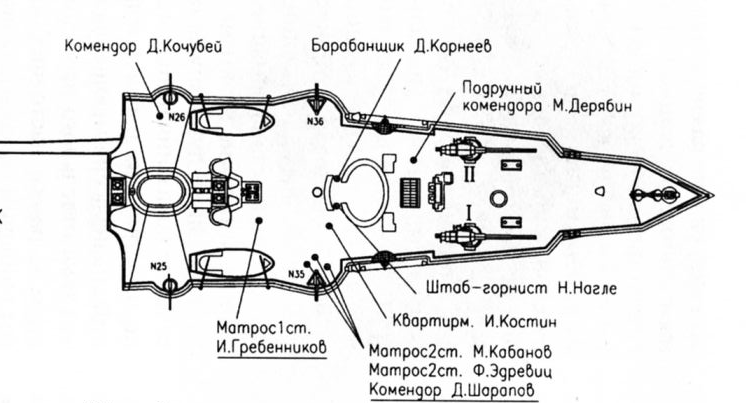
We’ll see that in the battle house, in addition to the miner and the drummer, five more crew members were killed during the battle: quartermaster, commander, sailor of the 1 article and two sailors of the 2 article. In this case, the places of their death are just in the zone of destruction of the Japanese projectile. Thus, this hit of an 203-mm projectile from the Assam, in addition to causing problems with cruiser control, killed 2 to 7 people.
The question of the “almost simultaneous” hit of several 152-mm projectiles in the middle of the Varyag case, which was observed from the Asama, remains open. Apparently, the Japanese armored cruiser recorded a hit with "Naniwa", described by us earlier. But it is interesting that at the same time, their projectile hit the “Varyag” on “Takachiho”: however, according to the results of the inspection of the “Varyag” by the Japanese, it can be argued that only three Japanese projectiles got into the bow of the ship's hull bridge wing, 152-mm at the wheelhouse and 203-120-mm - in the false side of the starboard). So, it is quite possible that Naniwa and Takachiho claim the same hit in the bulwark. However, another is also possible - the fact is that at some point in time the cruiser suffered damage to the third pipe located just in the middle of the hull, the time of which is not reflected either in Russians or in Japanese reports. Unfortunately, the author of this series of articles could not figure out, nor when this hit in the "Varyag" occurred, the projectile that hit the cruiser pipe flew in from any side.
During the rise of the "Varyag" his body was examined for the presence of various kinds of damage, and the Japanese themselves drew up their scheme, given in the monograph by A.V. Polutova. However, at the time of its compilation, the spars and the cruiser's pipes were cut, therefore the data on their damage were not included in the scheme. Only the scheme of V. Kataev remains, and a through-breakthrough of the third chimney is demonstrated on it, while the maximum damage (the torn off sheets of the outer casing) are on the starboard side. That's what it says? Perhaps the projectile hit the starboard side, exploded, and its fragments (the head?) Went through the pipe. It is possible that the projectile hit the port side, broke through the outer casing, the inner one, and exploded, thereby knocking the outer casing from the inside out. According to the author of this article, the first option is most likely, but it could have been different. Nevertheless, it can be assumed that "a few 152-mm hits in the middle of the hull," which were observed on the Asam, and hits to the cruiser, which recorded the Naniwa and Takachiho, are hits on the starboard and third pipe.
However, there is another, not completely understandable damage. The fact is that after the recovery of the cruiser, the presence of another hole in the starboard, in addition to the above, was found. It had the size of 0,72 * 0,6 m and was located in the area of the 82-th frame, between the stern bridge and the extreme side gun (№9). The Japanese did not observe this hit, but in the Varyag logbook there is a record: “The shell that went through the officers (cabins) that were destroyed, the deck was punched and the flour in the provision unit was lit.” However, this record refers to the time after 12.15, when the cruiser was deployed by the right side to the enemy, and could not get hit on the left side. In addition, the provisional compartment is located far enough from the point of entry (behind utytovye tools). At the same time, the “Combat Report” of the commander of the “Assam” contains an indication that an 203-mm projectile hit the stern, which happened a little earlier in 12.10: “An 8-inch projectile hit the deck behind the stern bridge. There was a strong fire, the foregast mast hanging over the starboard. ” However, it is extremely doubtful that the 203-mm projectile left behind so insignificant, just 0,43 square meters. a hole.
Most likely, this was the case. In the period from 12.00 to 12.05, while the cruiser was going to traverse about. Phalmido (Yodolmi), literally in 5 minutes "Varyag", got three or four hits (in the bridge, the stern and main-mars, probably another projectile exploded over the shkantsami, hitting the rigging) lost 10-15 people killed, after which passing traverse o. Phalmido-Yodolmi began to turn right. Here, in 12.06, three or even four shells hit the Russian cruiser almost simultaneously - one 203-mm next to the conning tower, and two-three 120-152-mm shells - one into the bulwark, one into the pipe and one into the stern district officer cabins. This was perceived on the "Asam" as a few hits in the middle part of the cruiser hull. As a result, "Varyag" lost control, and rolled into a turn on the rocks o. Yodolmi But when the cruiser turned left-side to the Japanese, he almost immediately (in the gap (12.06-12.10) gets two more direct hits. One of them (120-152-mm projectile) caused the flooding of the fire chamber and thus put a cross on the idea of a breakthrough, and the second - 203-mm projectile in the stern, which was mentioned in the “Combat Report” of the commander of the “Assam” caused the very fire, and the ignition of flour in the provisional compartment. the ships were not recorded, this damage was discovered during salvage operations.
As for the further (highlighted in blue) hit in the cruiser, then with them, not counting the projectile that flooded the stoker, everything is more complicated. The fact is that in the stern of the Varyag in the course of its lifting several damages of the hull were recorded:
1. two holes with 0,15 sizes on 0,07 m and 0,20 on 0,07 meters and 4 small holes next to them;
2. a hole the size of 3,96 on 6,4 m on the upper deck on the left side, there was a fire;
3. a hole on the upper deck with 0,75 dimensions on 0,67 meters.
So - with regard to damage under item 1, then they most likely arose either as a result of the scattering of fragments (metal structures of the hull) when 203-mm projectiles hit, or as a result of detonation of cruisers shells under the influence of fire. As for the 3,96 hole on 6,4 m, it looks too big for one 203-mm projectile - it is 5,3 times larger than the hole made by the 203-mm projectile at the Varyag squared room (25,34 m2 and 4,79 sq. . m. respectively)! Therefore, we can assume that, despite the well-known proverb “the projectile does not fall twice into one funnel,” this hole was the result of successive hits of two 203-mm projectiles (the first in 12.00 and the second in 12.10). And finally, the last hole was the result of hitting another projectile caliber 120-152-mm. Probably, this hit the cruiser received already when returning to Chemulpo, although, on the other hand, given that it was not recorded in either Japanese or Russian reports, the missile could get into the cruiser at any time during the battle.
Thus, we counted 10 hits in the hull and one - in the mast over the shkantsev, and apparently, 9 hits in the hull and one in the mast the ship received in the interval from 12.00 to 12.10, that is, in just 10 minutes. The Japanese believe that 11 shells got into Varyag, according to their other sources - 14.
We have already given the approximate position of battling ships as of 12.05. Their further maneuvering is not that interesting, but almost not amenable to reconstruction. We know that "Asama" turned on "Varyag" and went to him around 12.06. Apparently, it was precisely at this time that the "destruction of the rear bridge" and the "failure of the stern tower" of the armored cruiser of the Japanese were recorded on the Russian ships. It can be assumed that Russian sailors fell victim to optical illusion by taking a Japanese volley through the smoke of the previous one (and / or smoke from chimneys) for getting into the rear part of the “Assama”, and then, after the Japanese cruiser turned the Varyag, his stern tower, of course, could no longer act on the Russian ships - they were outside the sector of its shelling. But the combination of “clearly visible” “hitting” and ceasing firing from the aft tower, apparently, was “obvious” evidence of the damage to the “Assam” by Russian cannons - alas, as we know today, the evidence is false.
"Chiyoda" followed "Asama" to 12.18, after which, having problems with the power plant, fell behind. “Naniwa” and the next “Niitaka” completed the circulation and also turned to “Varyag”. Only the third pair of Japanese cruisers: "Takachiho" and "Akashi" did not immediately go to the "Varyag", but turned on the opposite course, moving in the direction of Fr. Herido, and only later, having made a circulation, turned towards Fr. Phalmido (Yodolmi). What Varyag did at this time we have already repeatedly analyzed in the articles of our cycle, and there is no point in repeating. Avoiding a meeting with the island, the Varyag returned to the fairway and moved to Chemulpo - the Japanese pursuing Russian ships stopped fire at 12.40, and Varyag anchored about a half cable from the British cruiser Talbot at 13.00-13.15.
It should be noted that upon receipt of the damage described above, the desire of V.F. Rudnev, at least temporarily, to take the ship out of the battle looks more than justified, and it’s not just a semi-underwater hole through which the stoker’s fire was flooded. Almost a great danger to the cruiser caused a fire in its aft, or rather, in the provisional compartment, where flour was burning. The danger of such a fire is usually completely underestimated, and completely in vain. The fact is that the combination of flour dust, oxygen and open fire under certain circumstances creates "gorgeous" volume explosions.
An “interesting” incident occurred in Benin in 2016. There, due to a violation of the technology of waste disposal, the spoiled flour was not completely burned, and its (apparently smoldering) residues were thrown into a landfill. The enterprising local population rushed to collect flour, hoping to “get hold of Darmeschinska,” and at that time an explosion thundered. The result is 100 dead and 200 injured. In general, for the year in the world at grain processing facilities occurs before the 400-500 explosions.
But back to the Russian ships. In the return of "Varyag" and "Koreyets" there would be nothing so interesting if it were not for one bike that went on a walk around the expanses of the Internet with a light hand of N. Chornovil. In his words, the cruiser Varyag, wishing to get out of the battle, managed to develop speed in 20 knots or even more: of course, even a somewhat impartial analysis of the battle shows that no such "super speed" Varyag on the way to Chemulpo did not develop .
The assertion that the Varyag, allegedly scattering from all its feet, comes from speculation in the battle plan, because, unfortunately, we do not know the exact position of the cruiser at each time point after 12.05, when he passed the traverse of Father Phalmido (Yodolmi) and before 13.00 (according to Korean Koreon watch log ship) or 13.15 (according to Varyag watch log) when the latter anchored, returning to Chemulpo raid.
What do we know?
The military report of the commander of "Assamy", Yashiro Rokuro testifies:
Apparently, the moment is described here when the Varyag already “passed back” from the island and gave way, turning to the right - since the turn “to the island” practically left the cruiser without a turn, and then it also reversed, then the resumption of movement Obviously, it was regarded by the “Asam” as an increase in speed. Then, at some point, “Varyag” disappeared from “Asama” behind an island, while the “Koreyets” could still fire at the enemy.
Thus, the following scheme for maneuvering Russian ships suggests itself:
This scheme is quite consistent with the report of the commander of "Akashi": "In 12.50 (12.15), the Russian ships, having made a circulation, lay down on the opposite course and began to retreat to Chemulpo."
Further, Yashiro Rokuro writes: “In 13.15 (12.40, Russian time), the enemy approached the anchorage of Chemulpo and stood between the ships of foreign countries. I stopped the fire. ” The fact that the Japanese stopped firing at 12.40 is confirmed by the Varyag logbook:
However, the Russian cruiser noted that the Japanese ceased firing not when the Varyag stood up “between ships of foreign countries”, and when the Japanese fire became dangerous for foreign stationery, which, generally speaking, is completely logical. It is impossible to imagine that the Japanese continued to fire the Russian cruiser when it was in close proximity to foreign ships. In addition, if all of a sudden it turned out to be true, then it is completely incomprehensible how Varyag, having reached its place in 12.40, managed to anchor only in 13.00 (if Korean Kore’s logbook is right) or even in 13.15 (about which the watchman magazine "Varyaga")?
True, "Korean" indicates that the Japanese stopped the fire not at 12.40, but at 12.45, but there could have been a mistake in there. The Varyag logbook noted that the Russian cruiser stopped firing 5 minutes later than the Japanese, while 12.45, perhaps seeing the Varyag firing on the Koreyts, considered that the Japanese cruisers continued to respond to him, although in fact this was not the case.
Thus, the following reconstruction suggests itself: At 12.15, Varyag was already walking along the fairway at the Chemulpo raid, at 14.40, on the way to the raid, the Japanese stopped firing and, at 12.45, apparently, when entering the raid or a little later, it ceased fire and "Varyag". In 13.00, Varyag is suitable for a parking lot, in 13.00-13.15 it gives up an anchor. So 6 is miles from about. Yodolmi before the raid (rather, even a little less, since the cruiser was already behind the island in 12.15) Varyag passed through 12 nodes - taking into account the oncoming flow around the 2,5 node, its speed did not exceed the 14,5 nodes, but rather was even less. No 17, 18, or even 20 nodes, of course, the cruiser did not develop.
As a matter of fact, if you ignore the Russian reports, declaring them false, and also completely abandon common sense, believing that “Asama” stopped firing at “Varyag” only when it anchored next to “Talbot”, substantiate "that approximately 6-6,5 miles from Fr. Phalmido flew to the anchorage in the Varyag road in 20 minutes or even less. However, supporters of this version for some reason forgot about the gun "Korean".
Well, let's say everyone lies, and the Varangian could really fly in the Chemulpo water area at a speed of 20 knots. Good. But the gunboat "Korean" could not do this! Its maximum speed in the tests was 13,7 knots, but the average was, of course, lower, and there is no evidence that on January 27, 1904, that is, approximately 17,5 years after its acceptance tests, “Korean "Could develop a great speed. Conversely, a minimal understanding of the realities of steam fleet of those years tells us that, most likely, the speed of the “Korean” was even lower than the 13,5 knots put to it “according to the passport”.
But no one has yet taken it upon to disprove the fact that the "Koreyets" turned around and went to the fairway of Chemulpo almost simultaneously with the "Varyag". And if the cruiser really gave 18-20 knots, then obviously the gunboat was far behind - with a difference in the speed of 4,5-6,5 knots in 20 minutes, the lag would be 1,5-2,17 miles. Suppose that is how it was: but in this case, the Japanese cruisers had no reason to stop firing at 12.40. They would simply transfer it from “Varyag” to “Korean” and continue to shoot further!
In other words, ignoring some reports, and tearing out phrases from others from the context, it is technically possible to imagine a situation in which Varyag ran to Chemulpo at the speed of 20 nodes and even more. But in this case it is completely unclear how the “Korean” did not lag behind the high-speed cruiser. And if it still fell behind, then why did the Japanese ships not transfer fire to it? It turns out that they shot at Varyag almost right up to the moment of anchoring, and the Koreets were released, although he clearly did not even have time to enter the raid?
In fact, on "Varyag", after V.F. Rudnev decided to get out of the battle, gave no more 13,5-14 nodes, that is, not much more than the maximum that the cannon could have developed, and if the Koreets were behind the Varyag, then not much more; raid almost simultaneously, approximately in 12.45-12.55.
A few words about the accuracy of shooting of Japanese cruisers. The consumption of the shells of Japanese cruisers, together with the distances of the battle, we will look at the table compiled by AV Polutovym
Assuming that Varyag received 3 hits with 203-mm shells and 8 with 120-152-mm caliber, we have% hits with 11,11% 203-mm and 3,16% 120-152-mm. It is very difficult to calculate the percentage of hits for individual ships, since, apart from 203-mm projectiles, it is unclear from which particular ship a particular hit was made. But if we assume that the Japanese “Battle Reports” are not mistaken, and that “Naniwa” and “Takachiho” achieved one hit, while the others were the result of shooting “Asam”, then it turns out that the six-inch “Assam” showed 5,82%, “Naniwa” "- 7,14%," Takachiho "- 10% accuracy. Yet this is highly doubtful, because the number of spent shells of the last two cruisers is extremely small, and the Takachiho was also almost the furthest away from the Varyag. As we saw above, Varyag received almost all its hits literally in some 10 minutes, and here it is rather difficult to single out the hit of its projectile. It can be assumed that all hits in “Varyag” were achieved from “Assam”, in this case the accuracy of its 152-mm guns was 7,77%.
The abnormally high accuracy of shooting a Japanese armored cruiser draws attention. On the same day, the main forces of the Japanese fleet entered into an approximately 40-minute battle with the Russian squadron at Port Arthur - using the 1 139 shells of the 152-203 caliber, the Japanese achieved a maximum of 22 hits, which is no more than 1,93%. What is the reason for such accurate shooting of the guns of "Asama"?
Unfortunately, the author does not have an answer to this question, but there is some assumption, a hypothesis. The fact is that “Asama” for a long time could not target at “Varyag” - having opened fire on 11.45 in Russian time, he achieves the first hit only after a quarter of an hour, at 12.00. This, generally speaking, is far from the best result - “Varyag” goes along the fairway, the position of which is known, its speed is frankly small, and nevertheless “bang-bang - and by”. Recall that the 6 lead ships ZP Rozhdestvensky in Tsushima, in much worse weather conditions, the Japanese ships 25 were able to hit with shells, of which 19 fell into Mikasu, the flagship of H. Togo.
However, then on the "Asam" still shot, and then thrust at an average projectile every minute. Why is that? The unsuccessful “Varyag” maneuver, here, perhaps, did not even play a special role, because, as we see, the majority of the hits fell on the starboard side of the cruiser, that is, before the “Varyag” made a U-turn island ", turning to the enemy left side.
Perhaps the sharply increased accuracy of the Japanese gunners is related to the fact that the Varyag approached about. Phalmido (Yodolmi), whose position in space was well known - as a result of this, the Japanese range-finders and gunners received an excellent reference point. This hypothesis is also confirmed by the fact that later, when the Varyag departed from the island, returning to the fairway, the armored cruiser Asama, although it continued pursuit and fired, apparently did not achieve more direct hits. That is, there is an interesting picture - the Japanese did not get into the "Varyag" on clean water, but as soon as he approached Fr. Phalmido (Yodolmi), as their fire gained deadly accuracy, which the Japanese armored cruisers, apparently, in any episode of the Russian-Japanese war have not reached. But for some reason, this super-accuracy was immediately lost, as soon as “Varyag” once again moved away from the island.
As for the Russian cruiser, he, having spent approximately 160 152-mm and 50 75-mm shells, apparently did not achieve hit in the Japanese ships. "Korean" released on Japanese ships 22 203-mm, 27 152-mm and 3 75-mm projectile, also, alas, without success. Arguing theoretically, we can assume that one or two projectiles did hit the Japanese - it is possible that if such hits did not harm the Japanese, the latter did not reflect them in the reports, but there is no evidence that from Varyag really hit someone no. As for the "sunk" Japanese destroyer, it remains to quote the report of the commander of the 14-th detachment of the destroyers, the captain of the 3-rank Sakurai Kitimaru, more precisely that part of it, which directly related to the battle:
Thus, all three Japanese destroyers participating in that battle practically followed the “Naniwa” and did not attempt to approach the Russian ships - hence, Varyag did not have the opportunity to sink one of them, or at least damage the Varyag.
It seems that everything is clear - "Varyag" and "Korean" could not inflict any noticeable damage to the enemy. Nevertheless, there are several odd explanations for which the author of this article does not have - we will consider them a little later, in the next article, since there is simply no room left for this here.
And, finally, the loss of the crew "Varyag".
According to the cruiser watch journal, for the 27 battle of January 1904, Varyag lost 31 people killed, 27 people seriously injured, 58 people less seriously injured, and 116 people of whom 58 were either killed or seriously injured. Later, in the report to the Marine Ministry Manager, Vsevolod Fyodorovich Rudnev indicated killed 31 people, more or less seriously injured 88 people (three officers and 85 lower ranks), as well as 100 people who were slightly injured, who did not report their injuries immediately after the fight. How realistic is such a loss estimate, and how to understand “less seriously” or “more or less seriously” injured?
Let us turn to the article by T. Austin (in modern transcription - T. Austin), an English maritime doctor, among other colleagues, who went up to the deck of the Varyag in order to help the wounded Russian sailors in the battle. He is a foreigner, an eyewitness, a representative of a nation that was completely unwilling to Russians in that war. In the discrediting relations with Vsevolod Fyodorovich Rudnev, in which our revisionists like to blame the commanders of the French and Italian cruisers, was not noticed.
The first thing I would like to say is the version of the twenty-minute flight of the Varyag from Fr. Phalmido to the place of anchorage in the roads T. Austin does not confirm. He writes: “Half an hour after the end of the battle, the Varyag returned to Chemulpo’s raid with a lurch to the left and with a burning stern.” Isn't it true, a noticeable similarity with the Russian cruiser's logbook, which states that the battle stopped at 12.45, and anchored the ship at 13.15? But we read further:
Let's try to translate it from the "medical" into Russian. The 5 doctors, during the 2 hours of 15 minutes, were able to somehow treat the wounds of just “about 60” victims in battle. Even if they are 60, for every doctor there are 12 patients - a total of 11,5 minutes were spent on each one, and this is only the provision of first-aid and emergency care!
It is obvious that it was not about scratches.
But it is also necessary to understand that the Russian doctors of “Varyag” during the battle and returning to Chemulpo’s raid were not inactive either - they brought the wounded and they worked with them even before their foreign colleagues boarded the cruiser. In addition, T. Austin notes that some of the wounded and even first aid did not have time to provide on the "Varyag" and it was rendered after the evacuation of the Russian crews to foreign stationery.
In view of the foregoing, the information of V.F. Rudnev, if not completely reliable, then extremely close to the truth. This suggests the assertion that the 85-88 man, indicated by the wounded, the vast majority could no longer perform their official duties. And taking into account the 31 people killed during the battle, we can state that the data on the failure of the 45% of the personnel whose combat command was located on the upper deck, compiled by R.M. Melnikov quite reliable.
Without a doubt, the cruiser Varyag received not so many direct hits. Nevertheless, even leaving the controversial data on the failure of artillery (as we discussed earlier, there is no reason not to believe the data of VF Rudnev about the mass failure of 152-mm guns, but still) we see that “Varyag "Received heavy damage to the hull (roll on the port side to 10 hail, fires) and suffered heavy losses in personnel, completely precluding further attempts to break through.
Yes, the main damage "Varyag" got literally in the course of the force 15, but rather even 10 minutes (from 12.00 to 12.10). But in the rest of the time, projectiles exploded alongside its sides, scattering the ship with splinters that killed and wounded Russian sailors. In view of the foregoing, the well-known picture of Pyotr Timofeyevich Maltsev “The Varyag Commandors Are Fighting” does not at all seem to be an excessive artistic exaggeration - in the opinion of the author of this article, this is how it was.
In conclusion of this article, I would like to quote the words of the Talbot ship doctor, T. Austin, who, as we said above, is difficult to suspect of secret sympathies for the crew of the Russian cruiser:
Продолжение следует ...
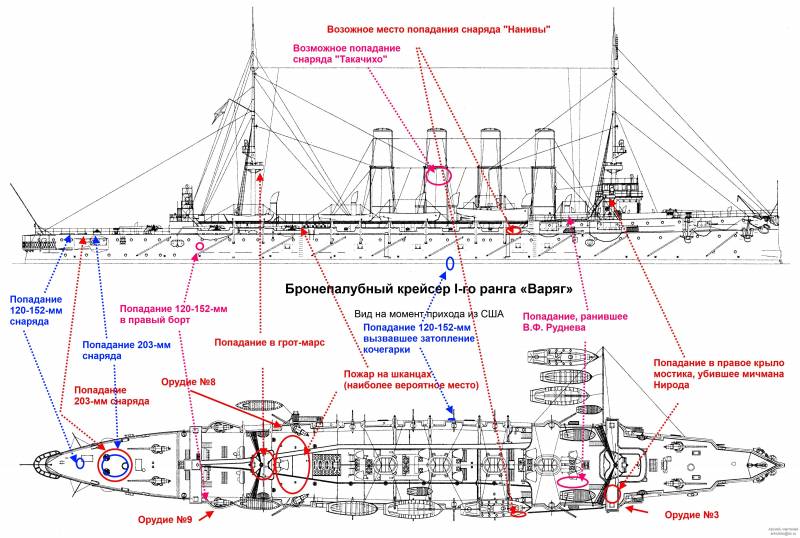
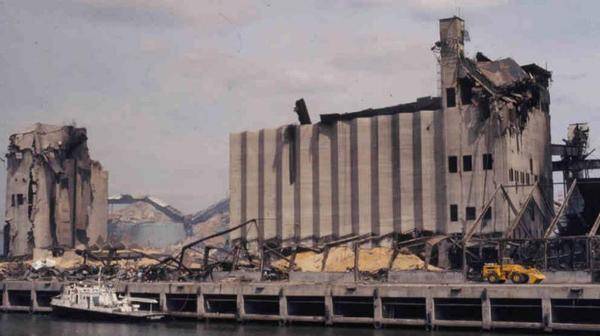
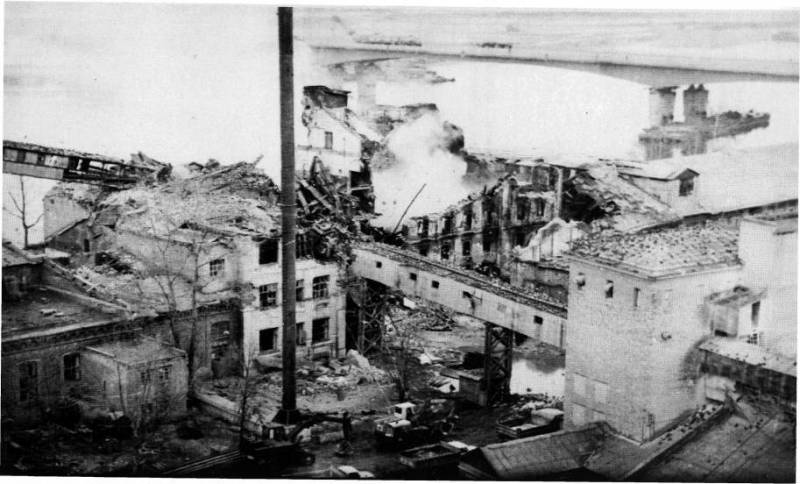
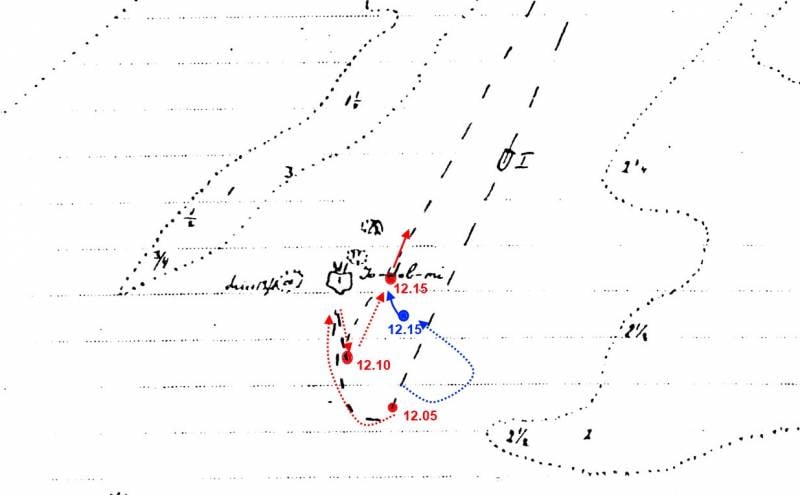
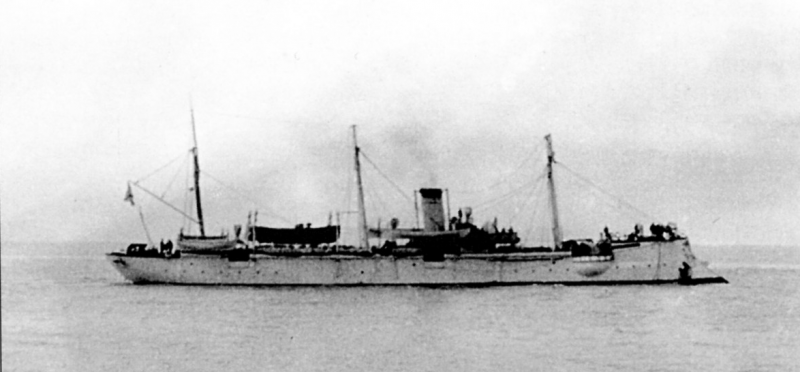
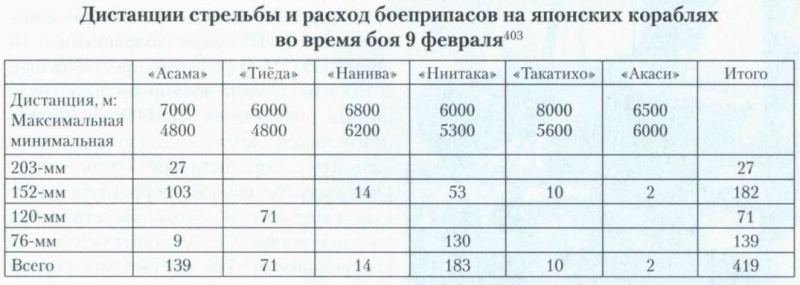
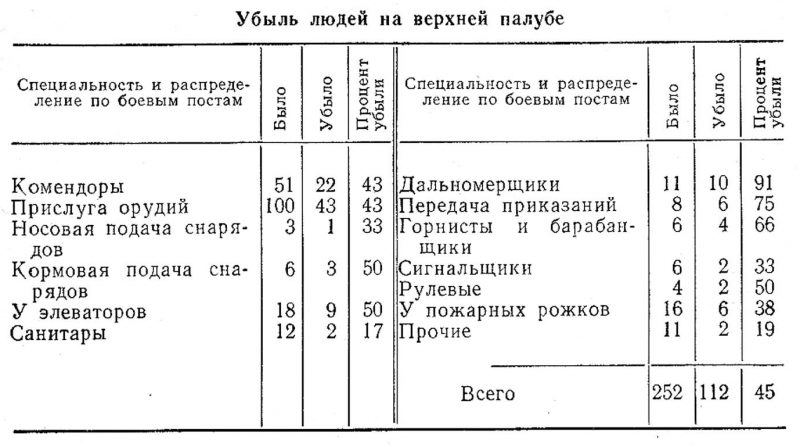
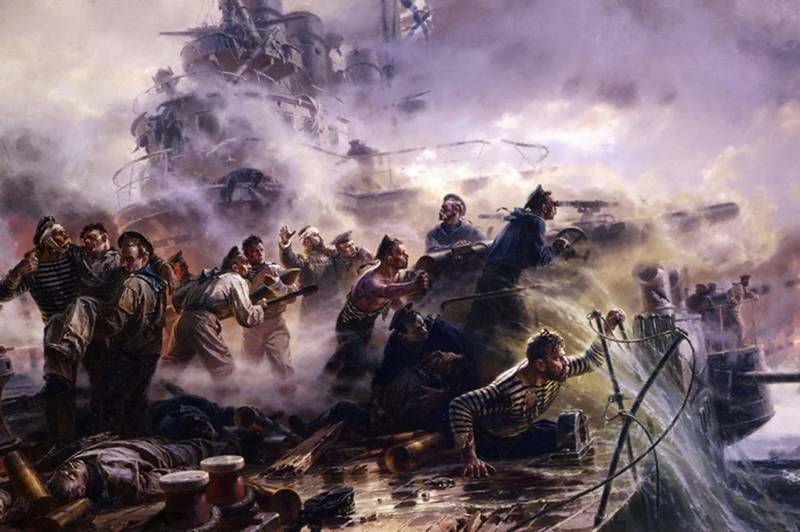
Information